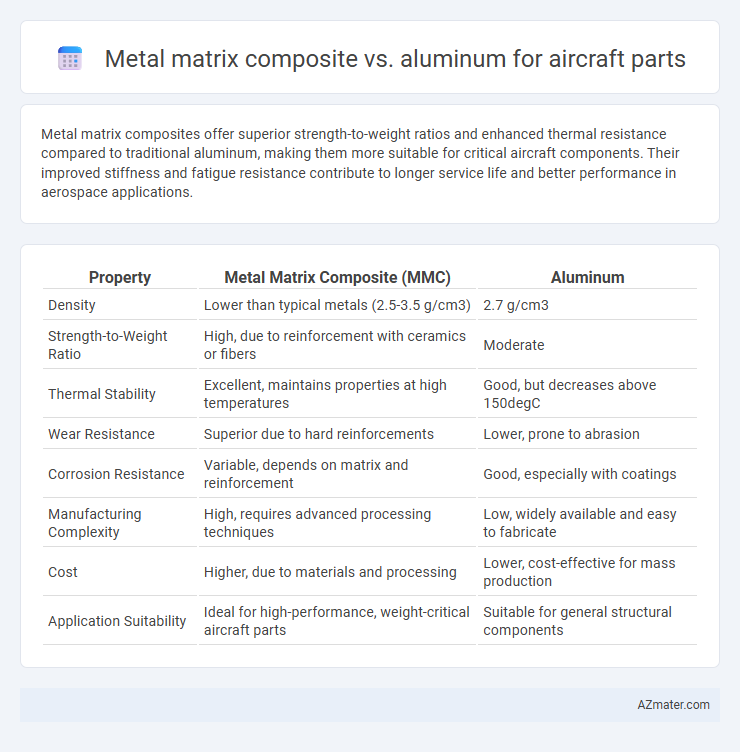Metal matrix composites offer superior strength-to-weight ratios and enhanced thermal resistance compared to traditional aluminum, making them more suitable for critical aircraft components. Their improved stiffness and fatigue resistance contribute to longer service life and better performance in aerospace applications.
Table of Comparison
| Property | Metal Matrix Composite (MMC) | Aluminum |
|---|---|---|
| Density | Lower than typical metals (2.5-3.5 g/cm3) | 2.7 g/cm3 |
| Strength-to-Weight Ratio | High, due to reinforcement with ceramics or fibers | Moderate |
| Thermal Stability | Excellent, maintains properties at high temperatures | Good, but decreases above 150degC |
| Wear Resistance | Superior due to hard reinforcements | Lower, prone to abrasion |
| Corrosion Resistance | Variable, depends on matrix and reinforcement | Good, especially with coatings |
| Manufacturing Complexity | High, requires advanced processing techniques | Low, widely available and easy to fabricate |
| Cost | Higher, due to materials and processing | Lower, cost-effective for mass production |
| Application Suitability | Ideal for high-performance, weight-critical aircraft parts | Suitable for general structural components |
Introduction to Advanced Aircraft Materials
Metal matrix composites (MMCs) exhibit superior strength-to-weight ratios, thermal stability, and wear resistance compared to conventional aluminum alloys in advanced aircraft materials. Incorporating ceramic reinforcements within metal matrices enhances mechanical properties, making MMCs ideal for critical structural components subject to high stress and temperature. The evolution from aluminum to MMCs in aerospace engineering drives improvements in fuel efficiency, durability, and performance of aircraft parts.
Overview of Metal Matrix Composites (MMCs)
Metal Matrix Composites (MMCs) combine a metal matrix, typically aluminum, with reinforcement materials like ceramics or fibers to enhance mechanical properties such as strength, stiffness, and wear resistance. MMCs offer superior thermal stability and fatigue resistance compared to conventional aluminum alloys, making them ideal for high-performance aircraft components subjected to extreme conditions. These composites provide tailored material properties that improve fuel efficiency and structural durability in aerospace applications.
Properties of Aluminum in Aerospace Applications
Aluminum alloys in aerospace applications offer an exceptional strength-to-weight ratio, corrosion resistance, and excellent thermal conductivity, making them ideal for structural components and fuselage parts. Their high machinability and cost-effectiveness support large-scale manufacturing and repair processes in the aviation industry. Despite lower stiffness compared to metal matrix composites, aluminum's fatigue resistance and ease of recycling remain critical advantages for aircraft durability and sustainability.
Strength-to-Weight Ratio: MMCs vs Aluminum
Metal matrix composites (MMCs) exhibit a superior strength-to-weight ratio compared to aluminum alloys, making them highly advantageous for aircraft parts demanding high structural integrity and reduced mass. MMCs, combining lightweight metallic matrices with ceramic reinforcements, deliver enhanced stiffness, fatigue resistance, and thermal stability, outperforming conventional aluminum in critical aerospace applications. This improved performance allows for weight savings and increased fuel efficiency in aircraft design without compromising safety or durability.
Corrosion Resistance Comparison
Metal matrix composites (MMCs) exhibit superior corrosion resistance compared to aluminum alloys used in aircraft parts due to their tailored reinforcement phases that enhance chemical stability in harsh environments. Unlike conventional aluminum, MMCs resist pitting and crevice corrosion, significantly reducing maintenance costs and extending service life. This improved corrosion resistance makes MMCs ideal for critical aircraft components exposed to varying atmospheric conditions and potential galvanic corrosion.
Thermal Performance in Aircraft Environments
Metal matrix composites (MMCs) exhibit superior thermal performance compared to aluminum in aircraft environments, offering higher thermal conductivity and better resistance to thermal deformation under high-temperature conditions. MMCs such as aluminum reinforced with silicon carbide particles maintain dimensional stability and improved heat dissipation, crucial for engine components and airframe structures exposed to fluctuating thermal stresses. The enhanced thermal fatigue resistance of MMCs reduces maintenance frequency and extends service life, outperforming conventional aluminum alloys in demanding aerospace applications.
Fatigue and Durability Analysis
Metal matrix composites (MMCs) enhance fatigue resistance and durability in aircraft parts compared to traditional aluminum alloys due to their superior strength-to-weight ratio and thermal stability. MMCs exhibit improved crack growth resistance and higher fatigue limits under cyclic loading, making them suitable for high-stress structural components. Aluminum alloys, while lightweight and corrosion-resistant, generally demonstrate lower fatigue endurance and are more susceptible to microstructural degradation over prolonged service periods.
Manufacturing and Cost Considerations
Metal matrix composites (MMCs) offer superior strength-to-weight ratios and enhanced wear resistance compared to aluminum, making them ideal for high-performance aircraft parts; however, their manufacturing involves complex processes such as powder metallurgy or casting with reinforcement integration, leading to higher production costs. Aluminum remains favored for aircraft components due to its ease of fabrication, established machining techniques, and lower raw material expenses, resulting in more cost-effective manufacturing. The choice between MMCs and aluminum hinges on balancing performance benefits against increased manufacturing complexity and economic constraints in aerospace applications.
Case Studies: MMCs and Aluminum in Aircraft Parts
Case studies reveal that Metal Matrix Composites (MMCs) outperform aluminum in aircraft parts by providing enhanced strength-to-weight ratios and superior wear resistance, crucial for high-stress components like turbine blades and landing gear. Research on MMCs incorporating aluminum matrices reinforced with ceramic fibers demonstrates significant improvements in fatigue life and thermal stability compared to traditional aluminum alloys. Comparative analyses illustrate that MMCs contribute to fuel efficiency and operational durability, making them increasingly preferred in advanced aerospace engineering applications.
Future Trends and Material Selection in Aerospace
Metal matrix composites (MMCs) demonstrate superior strength-to-weight ratios and thermal stability compared to traditional aluminum alloys, making them increasingly preferred for future aerospace applications requiring enhanced performance under extreme conditions. Advancements in fabrication techniques like powder metallurgy and additive manufacturing are expanding MMCs' viability, while aluminum remains favored for cost-effective, corrosion-resistant components with established manufacturing workflows. The aerospace industry's material selection is progressively driven by the need for fatigue resistance, damage tolerance, and fuel efficiency, positioning MMCs as a critical element in next-generation lightweight aircraft structures.

Infographic: Metal matrix composite vs Aluminum for Aircraft part
 azmater.com
azmater.com